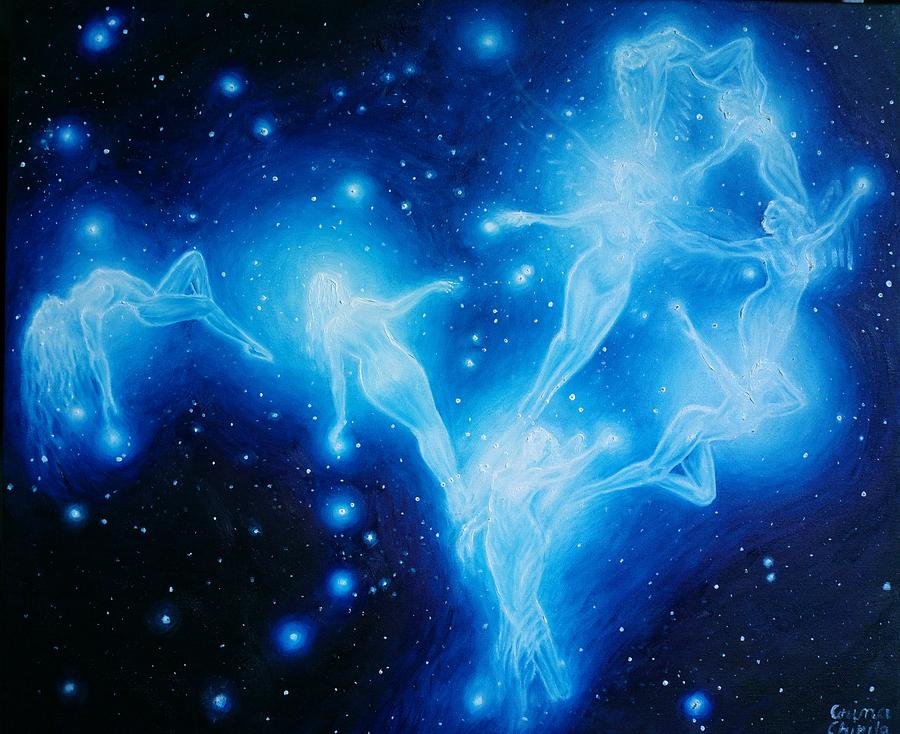
Celestial Archetypes and Cultural Cosmologies: The Pleiades in Ancient Traditions
Oracle SothisThe Pleiades, an asterism of stars visible to the unaided eye, have been vested with profound cosmological and mythological significance across diverse ancient civilizations. These celestial entities, often conceptualized as a cluster of sisterly figures, are deeply embedded in a multiplicity of cultural frameworks, where they symbolize both the order of the cosmos and divine orchestration. The periodicity of their heliacal risings and settings has historically delineated seasonal transitions, thereby structuring ritual practices and agricultural schedules. In this exposition, we engage in an exhaustive comparative analysis of the Pleiades as conceptualized within ancient traditions.
In the Hellenic corpus, the Pleiades are identified as the seven daughters of the Titan Atlas and the Oceanid Pleione. Classical mythology recounts that these sisters were relentlessly pursued by Orion, the eminent celestial hunter, and were ultimately transformed into stars to secure their preservation. Nevertheless, Orion perpetually pursues them across the night sky, manifesting a cosmological narrative of unceasing pursuit and celestial protection. The cluster's heliacal rising in May traditionally demarcated the advent of the sailing season, while its subsequent autumnal setting presaged the oncoming winter. Thus, the Pleiades functioned as pivotal astronomical indicators within Greek maritime and agrarian systems.
In the cosmological framework of ancient Egypt, the Pleiades occupied a comparatively marginal position relative to more prominent celestial bodies such as Sirius and Orion. While sporadically referenced as a star cluster, the Pleiades did not hold a substantial role in Egyptian mythopoeic constructs or calendrical systems. The heliacal rising of Sirius, rather than the Pleiades, was the cardinal celestial event, signifying the inundation of the Nile and the inception of the new year. The absence of significant ritual association with the Pleiades underscores the primacy of other astral phenomena within Egyptian cosmology.
The Mesopotamian paradigm, particularly that of the Sumerians and subsequent Babylonian traditions, identified the Pleiades as MUL.MUL, denoting the “Stars of Stars.” Their aggregation signified a divine council or cosmic assembly, intricately linked to the god Ninurta. Astronomical texts and omens from this region frequently cited the Pleiades as harbingers of divine favor or portents of cosmic upheaval. Their function as a cohesive unit emphasized the ideological valorization of unity and collective power, resonating with Mesopotamian theologies centered around divine order and social stability.
Indigenous American cultures ascribed substantial cosmological and ritual significance to the Pleiades. Among the Maya, the cluster was known as “Tzab-ek” or “The Rattlesnake’s Rattle,” signifying the renewal of creation and the cyclicality of existence. The Pleiades marked the termination and rebirth of the agricultural calendar. The Aztec civilization, by contrast, linked the cluster with eschatological prophecy, particularly within the New Fire Ceremony, where its zenith at midnight affirmed the continuity of the cosmos. The ritual, embodying cosmic rebirth, underscored the enduring cultural apprehension of catastrophic renewal.
In the Andean cultural matrix, the Inca perceived the Pleiades as emblematic of agrarian fecundity and ancestral guidance. Their heliacal rise aligned with the onset of the planting season, integrating the celestial with the terrestrial sphere of cultivation. The Pleiades, thereby, symbolized a celestial convocation of ancestral spirits, orchestrating agricultural prosperity and maintaining cosmological equilibrium.
Within the mythopoetic traditions of Australian Aboriginal societies, the Pleiades are frequently construed as female ancestral beings pursued by male hunters, often paralleling the Greek narrative of Orion. These myths encode a cosmological ethos wherein the stars embody social and spiritual paradigms, mediating between human existence and ancestral cosmogenesis. Fertility, renewal, and moral narratives are interwoven with the celestial motions of the Pleiades.
The Pleiades are known as the Krittikas in Vedic tradition, associated with the war deity Kartikeya. As six maternal figures nurturing the divine warrior, their astronomical emergence marks the cessation of the monsoon and heralds the return of arid conditions. This association with martial energy and climatic transition underscores their symbolic resonance within agrarian and martial contexts.
In the Japanese cultural lexicon, the Pleiades are termed “Subaru,” a denomination signifying unity and convergence. This motif of harmonic cooperation is visually manifest in modern iconography, reflecting a continuity of symbolic interpretation from ancient cosmology to contemporary cultural expressions.
The cosmologies of Native American tribes, while diverse, often depict the Pleiades as a constellation of maidens or vulnerable children. For the Lakota and other Plains tribes, they embody the “Seven Sisters,” celestial protectors ensconced within the sky. The Navajo tradition situates the Pleiades within the “Black God” constellation, attributing to them a role of spiritual guardianship and didactic guidance.
Across these diverse traditions, the Pleiades emerge as an archetype of cohesion, transformation, and renewal. Their consistent association with cycles of rebirth and cosmic regulation testifies to their enduring presence within the mythological architectures of ancient civilizations. The Pleiades, as luminous heralds of seasonal change and mythic narratives, continue to exemplify the profound symbiosis between human cultural consciousness and the immutable cosmos.
Artist of the image is Chirila Corina.
